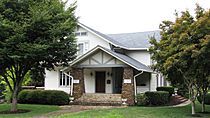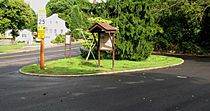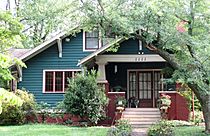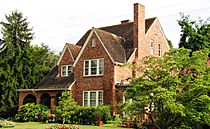Island Home Park, Knoxville facts for kids
Quick facts for kids |
|
|
Island Home Park Historic District
|
|
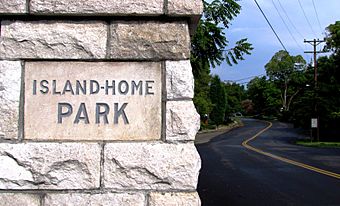 |
|
| Location | Bounded by Island Home Boulevard, Fisher and Spence places, and Maplewood Knoxville, Tennessee |
|---|---|
| Area | approximately 53 acres (21 ha) |
| Built | 1899–1940 |
| Architect | multiple |
| Architectural style | Bungalow/Craftsman, Tudor Revival, Colonial Revival, Minimal Traditional |
| NRHP reference No. | 94001260 |
| Added to NRHP | November 10, 1994 |
Island Home Park is a neighborhood in Knoxville, Tennessee. It's in the southeastern part of the city. This area is right along the Tennessee River. It started as a "streetcar suburb" in the early 1900s. This means people used streetcars to get around. Many original houses are still there. It has the most Bungalow-style homes in Knoxville. In 1994, many houses here became part of the National Register of Historic Places. This makes them important historical sites.
The land was once a farm called "Island Home." It belonged to Perez Dickinson, a businessman. He started the farm in the 1870s. A new bridge, the Gay Street Bridge, was finished in 1898. This helped the area grow. The Island Home Park neighborhood began the next year. Many professionals and managers lived here early on. They worked in Knoxville's businesses.
The Tennessee School for the Deaf campus grew next to Island Home Park in the 1920s. The Knoxville Downtown Island Airport also developed nearby. It was built on Dickinson's Island in the 1930s.
Contents
Exploring Island Home Park's Location
Island Home Park is on the south bank of the Tennessee River. It is just southeast of downtown Knoxville. The river forms its northern border. The Tennessee School for the Deaf is to the east. Island Home Avenue is on the west and south. Dickinson's Island is in the middle of the river. The Downtown Island Airport is on this island.
Island Home Boulevard cuts through the middle of the neighborhood. It's a true boulevard with a grassy area in the middle. This street, along with Spence Place and Fisher Place, has the oldest houses. Newer parts of the neighborhood are to the south and west.
A Look Back at Island Home Park's History
Knoxville businessman Perez Dickinson bought this land in 1869. He was a professor at East Tennessee College. He also helped start successful businesses. Dickinson built a large Italianate house on the property in 1875. This house is now part of the Tennessee School for the Deaf. He turned the land into a cattle farm. He named it "Island Home" after the island in the river. This island is now called Dickinson's Island.
Dickinson's farm was very large, about 600 acres (240 ha). About 200 acres (81 ha) of it had white picket fences. Island Home Boulevard was first the main road to Dickinson's house. He used the farm as a model for raising animals. In 1879, a newspaper wrote about a new farming machine shown at Island Home. It was probably the first time this machine was used in the area. The farm was also a place for clubs to meet.
The neighborhood started growing after the "new" Gay Street Bridge opened in 1898. This bridge had tracks for trolleys. For the first time, Knoxville and South Knoxville were connected by trolley. The Island Home Park Company was formed in 1899. Their goal was to build a suburb on land from Dickinson. Colonel Cary Spence was the company's president. Trolley tracks were put along the middle of Island Home Boulevard. House building began around 1910. Knoxville officially added Island Home Park to the city in 1917.
Many early residents were middle and upper-middle-class people. They were doctors, bankers, factory managers, and engineers. Actor John Cullum grew up here. He has spoken fondly about the neighborhood.
The Tennessee School for the Deaf moved to its current campus in 1924. It is just east of Island Home Park. The Downtown Island Airport began in 1930. It started as a flight service on Dickinson's Island.
Island Home Park Historic District: A Special Place
The Island Home Park Historic District has 91 important houses. They are on Island Home Boulevard, Spence Place, Fisher Place, and Maplewood. The two stone gateposts at the neighborhood's west entrance are also important. The old trolley turnaround and the grassy area in the middle of Island Home Boulevard are special sites. The most common house styles are Bungalow, Craftsman, and Tudor Revival.
Houses with History
- 1900 Maplewood Drive: This is a one-story Bungalow-style house. It was built between 1900 and 1910. It might even be older than the neighborhood itself.
- 1936 Maplewood Drive: A one-story Craftsman-style house. It was built around 1915 to 1920.
- 2004 Spence Place: This is a two-story brick Colonial Revival-style house. It has a French tile roof and was built around 1920. Ernest Neal, a Knoxville mayor, lived here in the late 1920s.
- 2036 Spence Place: A two-story Craftsman-style house built around 1916. John L. Greer, a judge, lived here. He owned the famous racehorse Foolish Pleasure, who won the 1975 Kentucky Derby.
- 2100 Spence Place: A two-story brick Tudor Revival house built around 1927. Carl Bock, an engineer for the Tennessee Valley Authority (TVA), lived here in the 1930s. He helped design several large dams.
- 2000 Island Home Boulevard: A Craftsman-style house with a fancy front porch. It was built around 1915.
- 2103 Island Home Boulevard: A one-story Craftsman-style house built around 1915. Herbert Holt, who started an engineering company, lived here. He was also the city manager for Gatlinburg, Tennessee.
- 2200 Island Home Boulevard: A one-story Tudor Revival house built around 1926. John Flenniken, a construction company president, lived here. Country music star Archie Campbell might have lived in a guest house on the property in 1936.
- 2221 Island Home Boulevard (Platt House): A two-story American Foursquare house built around 1915. The Platt family moved in during 1928. Their son, Samuel Platt, became a well-known local doctor.
- 2222 Island Home Boulevard: A one-story Craftsman-style house built around 1917. William A. McCallie, who owned an office supply business, first lived here.
- 2227 Island Home Boulevard: A one-story Tudor Revival house built around 1932.
- 2237 Island Home Boulevard: A two-story Craftsman-style house with Prairie School style influences. It was built around 1912. George A. Mary, a company manager, lived here in the 1930s and 1940s.
- 2245 Island Home Boulevard: A two-story Tudor Revival house built in 1927.
- 2316 Island Home Boulevard: A one-story Craftsman-style house built around 1927. Lewis P. Self, who owned a long-time electric company, first lived here.
- 2321 Island Home Boulevard ("Jeweland"): A two-story Bungalow-style house. It has large cobblestone pillars and was built around 1910.




